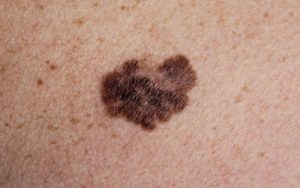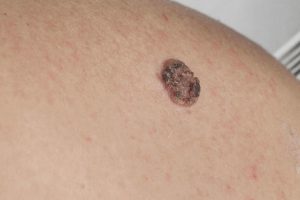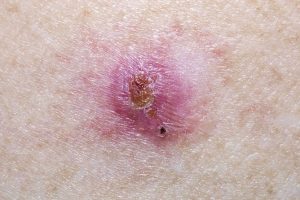What is Skin Cancer and How Does it Form?
Skin cancer is caused by the sun and exposure to its UV rays over time. It can also be caused by the use of tanning solariums. Solariums are now banned in Australia, but someone who used a solarium before age 35 has a much higher risk of developing melanoma – almost 60%.
Any cancer is the uncontrolled growth of cells in the body, and skin cancer is a cancer that affects the cells in the skin. It’s very common in Australia, with 2 in 3 Australians diagnosed with a form of skin cancer before the age of 70. You can learn more about skin cancer here.
How Can Skin Cancer Be Diagnosed?
Dermascope Spot Check
A dermascope is a brightly lit 10x magnifying tool that helps a clinician to have a good look at a skin lesion. With more detailed visibility, there is greater accuracy in diagnosing potential skin cancers on a patient. A clinician can more clearly see blood vessels, pigmentation, asymmetry and any disorganisation in shape or colour.
Full Body Map
A full body map gives a detailed overview of the health of your skin in terms of any lesions or pigmented patches that may be present. Full body mole mapping maintains a record of your moles, so that in later years you can come back and get another mole map done to compare to your previous one. This allows you to keep your moles in check and make sure they’re not showing signs of skin cancer. Early detection is crucial, making mole mapping an important early intervention.
Skin Cancer Check
A full body skin cancer check should be done every 12 months, or more often if you have a history of skin cancer. It involves a clinician looking over every inch of your body (you’ll be stripped down to your undergarments) and making note of any suspicious looking skin lesions, as well as magnifying them onto their computer screen using a dermascope. Photos may be taken of your body to document the health of your skin.
Treatment Options – Skin Cancer Surgery & Other Options
Mole removal is an important part of early skin cancer treatment and there are several methods for removing moles. The less invasive ones are radiofrequency mole removal and cryotherapy mole removal. In the former, concentrated radiofrequencies are used to shave off raised unharmful moles. Cryotherapy involves freezing off moles. There are also forms of skin cancer surgery such as excision, punch excision and shaving.
More About the Most Common 3 Types of Skin Cancer
There are different types of skin cancer, and some are more deadly than others. Here’s some information on the 3 most common types of skin cancer:
Melanoma

- Most dangerous
- Can spread
- Has no symptoms
Melanoma is the most dangerous type of skin cancer. If not caught and treated early, it can spread to other parts of the body and be fatal. It may appear in a mole or a dark spot or on clear skin. Usually it appears on parts of the body that are exposed to the sun, however, it may appear in areas where there is no or very little sun exposure.
Nodular melanoma is an especially rare type of skin cancer that is almost fatal. It appears as a new small round lump. It may be pink, red, black or brown in colour. It grows very quickly and can become life threatening in six to eight weeks.
Melanoma often has no symptoms, so it is very important to have regular checks. If caught early the cure rate is very high, but if caught late the cure rate drops significantly.
Squamous Cell Carcinoma

- Second most common
- Can grow and spread quickly
- A red scaly spot that doesn’t heal
Squamous cell carcinoma is the second most common skin cancer and can grow quickly within a few weeks or months. It accounts for about 30% of non-melanoma skin cancers. It is not as dangerous as melanoma but can spread to other parts of the body if not treated. It usually appears where the skin is exposed to the sun – head, ears, lips, neck, arms and legs. SCC on lips and ears are the most dangerous in terms of spreading. It usually appears as a thick red scaly spot that doesn’t heal.
Basal Cell Carcinoma
- The most common
- The least dangerous
- Grows slowly
The most common skin cancer accounts for about 70% of non-melanoma skin cancers. It is also the least dangerous. It usually appears as a lump or scaly area, originating in the top layer of the skin. It grows slowly. It could be red, pale or pearly coloured and is usually found on the face, nose, ears, neck, shoulders and back, however it could appear anywhere on the body. Sometimes it ulcerates or presents as a sore that doesn’t heal properly. Usually it can be easily treatable.
Do You Have a Suspect Mole?
If you have a suspect mole or you haven’t had a full body mole map in the last 12 months, it’s time to protect yourself against skin cancer. Book in for a mole map or skin cancer check with one of our expert clinicians today by calling us on 1800 665 324.




